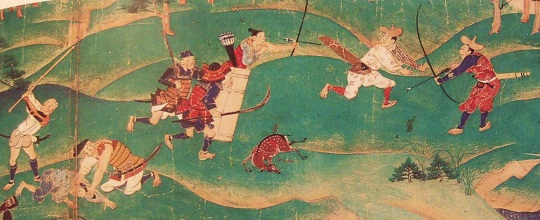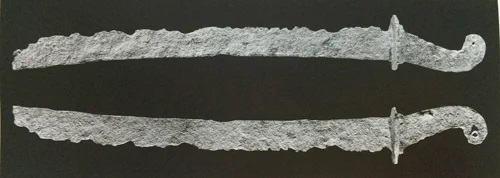Shichihode (七方出) - Ninja's Seven Disguises
Shichihode (七方出) - Ninja's Seven Disguises
A group of travelling merchants during the Edo period; one of the famous Ninja's famous disguises. From a Hiroshige's Ukiyo-e
Among the various arts and techniques a Shinobi was supposed to learn, the Shichihode (七方出) was one of the most useful when it comes to infiltration and espionage.
The Shichihode, which could be translated in "seven directions", are useful disguises associated with particular professions or social class used by various ninjas to travel unnoticed across the country in order to spy the others domains.
The Shichihode, which could be translated in "seven directions", are useful disguises associated with particular professions or social class used by various ninjas to travel unnoticed across the country in order to spy the others domains.
The disguises are listed in the Shoninki (正忍記), which was written in the late 17th century, when the Tokugawa Shogunate was in full control of the country and had a well developed spies network all across Japan; however, these disguises were likely to be used in the previous centuries as well, especially during the Sengoku period, when war was at its peak.
To better understand why the shinobi used these specific professions is important to highlight that during the Muromachi and Edo period, travelling was highly regulated and people couldn't move freely across the country, with few particular exceptions.
To better understand why the shinobi used these specific professions is important to highlight that during the Muromachi and Edo period, travelling was highly regulated and people couldn't move freely across the country, with few particular exceptions.
By exploiting these exceptions, the ninja were able to bypass various checkpoints without being stopped or interrogated by the local authorities.
Komusō (虚無僧)
Komusō (虚無僧)
The Komusō were mendicant monks famously known for their unique attire, made by a straw basket type of hat called Tengui (天蓋) which completely covered the face; a very useful tool for a ninja. They also carried a flute, which was used to practice Suizen (吹禅) and had the license to travel and to carry a sword during the Edo period.
These two features, together with the Tengui hat, made the Komuso one of the most useful and effective ninja's camouflage.
However, due to these obvious advantages, Komusō started to be discretely controlled during the Edo period.
The shinobi disguised as Komusō were supposed to be able to play the flute properly and act as monks.
However, due to these obvious advantages, Komusō started to be discretely controlled during the Edo period.
The shinobi disguised as Komusō were supposed to be able to play the flute properly and act as monks.
Modern day Komusō monks playing their flutes; it's quite easy to see why the ninja used this attire.
Yamabushi (山伏)
The Yamabushi were mountain ascetic hermits which practiced Shugendō (修験道).
They often wore a hood or a straw hat and a Kesa (袈裟), and they also carried a metal staff or an axe especially if they were supposed to start a meditation trip on the mountain.
Like the Komusō, since they were often associated with monastic orders, they had the permission to travel freely across the country.
Traditionally, the Yamabushi were often associated with mystical creature like the Tengu (天狗) and sometimes were involved in military affairs.
Modern day Yamabushi training in the forest
The Shukke were wandering Buddhist priests that travel across the country to engage in evangelism and training as well as visiting temples.
Even women could also become Shukke in some Buddhist traditions.
Since the Shukke was supposed to be in pilgrimage, they weren't questioned at the various checkpoints across Japan, and they were also able to carry a sword during the Edo period.
Modern day Buddhist priest on a pilgrimage
The Shōnin were the Japanese merchants and had the permission to travel freely across Japan; they weren't able to carry long swords during the Edo period, and if a ninja wanted to use this disguise, he was supposed to be able to sell a specific good and learn local dialects as well.
Two Samurai selling armors and broken swords to a scrap merchant, by Hiroshige
Some Hokashi performing on the streets
These were actors of Nō (能) theater and were free to travel from one city to another to perform shows. They also had the permission to enter in castles and heavily guarded places without being questioned that much, since many daimyo at that time were patrons of actors and often invited them in their own domain.
It is quite ironic that on some shows, the actors were supposed to act as supernatural ninja.
A Noh actor in the Edo period, with the typical facial paint.
The Yamabushi were mountain ascetic hermits which practiced Shugendō (修験道).
They often wore a hood or a straw hat and a Kesa (袈裟), and they also carried a metal staff or an axe especially if they were supposed to start a meditation trip on the mountain.
Like the Komusō, since they were often associated with monastic orders, they had the permission to travel freely across the country.
Traditionally, the Yamabushi were often associated with mystical creature like the Tengu (天狗) and sometimes were involved in military affairs.
Modern day Yamabushi training in the forest
Shukke (出家)
The Shukke were wandering Buddhist priests that travel across the country to engage in evangelism and training as well as visiting temples.
Even women could also become Shukke in some Buddhist traditions.
Since the Shukke was supposed to be in pilgrimage, they weren't questioned at the various checkpoints across Japan, and they were also able to carry a sword during the Edo period.
Modern day Buddhist priest on a pilgrimage
Shōnin (商人)
The Shōnin were the Japanese merchants and had the permission to travel freely across Japan; they weren't able to carry long swords during the Edo period, and if a ninja wanted to use this disguise, he was supposed to be able to sell a specific good and learn local dialects as well.
Two Samurai selling armors and broken swords to a scrap merchant, by Hiroshige
Hokashi (放下師)
The Hokashi were street entertainers which were licensed to travel freely in order to perform shows on the streets, which involved tricks, music, stunts and trained monkeys.
These performances are said to have originated into Buddhism, when some monks tried to spread the religion while doing streets shows.
The Hokashi were street entertainers which were licensed to travel freely in order to perform shows on the streets, which involved tricks, music, stunts and trained monkeys.
These performances are said to have originated into Buddhism, when some monks tried to spread the religion while doing streets shows.
Some Hokashi performing on the streets
Sarugakushi (猿楽師)
These were actors of Nō (能) theater and were free to travel from one city to another to perform shows. They also had the permission to enter in castles and heavily guarded places without being questioned that much, since many daimyo at that time were patrons of actors and often invited them in their own domain.
It is quite ironic that on some shows, the actors were supposed to act as supernatural ninja.
A Noh actor in the Edo period, with the typical facial paint.
Common man
The hardest, and yet the most effective disguise a shinobi could have used. Common men, like artisans, farmers or samurai didn't had the permission to travel from one domain to another, however, a ninja pretending to be a normal man was incredibly hard to recognize or spot.
This allowed the ninja to spy on the other clans with ease, while being constantly behind enemy lines.
Despite lacking several advantages that the other disguise had, this was probably the most used disguise, due to its high level of anonymity.
The hardest, and yet the most effective disguise a shinobi could have used. Common men, like artisans, farmers or samurai didn't had the permission to travel from one domain to another, however, a ninja pretending to be a normal man was incredibly hard to recognize or spot.
This allowed the ninja to spy on the other clans with ease, while being constantly behind enemy lines.
Despite lacking several advantages that the other disguise had, this was probably the most used disguise, due to its high level of anonymity.
A farmer in a Japanese Ukiyo-e, Edo period. He was also carrying a sword, which would have been illegal at that time for its social class.
I hope that this brief article was able to give you new information on the most common ninja's disguises! Please feel free to share it if you liked and for any questions feel free to leave a comment below.
Gunbai















Comments
Post a Comment